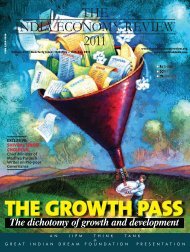Download - The India Economy Review
Download - The India Economy Review
Download - The India Economy Review
Create successful ePaper yourself
Turn your PDF publications into a flip-book with our unique Google optimized e-Paper software.
egions, but how to allocate appropriate<br />
funds for their development. A related,<br />
but equally important question is proper<br />
implementation of projects contemplated<br />
with all the good intention by the plan-<br />
ners.<br />
In the existing paradigm, backwardness<br />
is measured from Human Deprivation<br />
Perspective, based on Capability Short-<br />
falls in terms of different social and eco-<br />
nomic components. <strong>The</strong> approach takes<br />
the rule of uniformity by which the Back-<br />
ward Districts are identifi ed as per the<br />
components mentioned earlier by attach-<br />
ing equal weights to each one of them.<br />
However, the actual data gathered from<br />
Blocks may call for a differential approach<br />
of funding on various components which<br />
go towards the creation of an Index of<br />
Backwardness. In other words, not all<br />
components may be contributing uni-<br />
formly towards the existence of backward-<br />
ness in a Block. If Block is taken to be the<br />
unit of disbursement, a methodology<br />
should be devised to suitably differentiate<br />
the importance of different social and<br />
economic components of backwardness<br />
region and location wise.<br />
One such approach toward aggregating<br />
the components is Principal Component<br />
Analysis (PCA).<br />
Broadly speaking, Public Infrastructure<br />
can be categorized as follows:<br />
A. Physical Infrastructure, like Roads,<br />
Electrifi cation, Irrigation etc.<br />
B. Financial Infrastructure like Cooperatives,<br />
Banks etc.<br />
C. Health Infrastructure like PHC,<br />
SHC, Rural Hospitals etc.<br />
D. Education Infrastructure like number<br />
of schools, teacher student ratio etc.<br />
An aggregate index of backwardness with<br />
variable weights attached to shortfall of<br />
each type of infrastructure from a socially<br />
and economically desirable minimum<br />
could be calculated using PCA (Raychaudhuri<br />
and Haldar, 2009). <strong>The</strong> weights<br />
really refl ect importance of capability<br />
shortfall in any particular dimension according<br />
to local needs and conditions.<br />
<strong>The</strong> main problem with the existing<br />
planning process is to initiate well intended<br />
schemes based on certain uniform<br />
percentage based rules of allocation<br />
across all the backward regions in <strong>India</strong>.<br />
This approach is self-defeating from the<br />
very beginning because the uniform rule<br />
ignores the variation of locations and<br />
needs across different regions in <strong>India</strong>. It<br />
is about time more fl exibility is allowed in<br />
all such devolution schemes. What about<br />
corruption and other money laundering<br />
activities? We would suggest that these<br />
are really problems of monitoring and<br />
enforcement in the implementation stage<br />
and are not part of planning. One must<br />
fi rst try to achieve more perfection at the<br />
planning stage and then go for its perfect<br />
implementation. Thus, a proper mode of<br />
devolution of funds is the necessary condition<br />
of success to address backwardness<br />
and proper implementation is really a<br />
suffi cient condition for its success.<br />
Conclusions<br />
<strong>The</strong> issues raised above are to highlight<br />
some of the defi ciency in the planning<br />
process of <strong>India</strong> today. This is not to deny<br />
the historical importance of planning in<br />
<strong>India</strong> nor does it ignore its role at present.<br />
Planning, even in its much smaller role<br />
today, can be an important means of addressing<br />
concerns of average citizen in<br />
<strong>India</strong>. But what is required is a reorientation<br />
and repositioning of some of the<br />
goals and objectives pursued in our planning<br />
process for years. Also, equally important,<br />
is to rethink about modes of<br />
D EVELOPMENTAL PLANNING<br />
devolution of funds to alleviate poverty<br />
and inequality in the society. We should<br />
not succumb to a sense of despair that<br />
nothing can be implemented in a society<br />
which has lost some of its moral and ethical<br />
values. We must not forget that implementation<br />
comes later than planning and<br />
we should never err too much in the stage<br />
that precedes implementation.<br />
References and<br />
Additional Thinking<br />
• Banerjee, A., P. Gertler and M. Ghatak.<br />
“Empowerment and Effi ciency: <strong>The</strong><br />
Economics of Agrarian Reform”,<br />
Mimeo, 1998.<br />
• Desai, Padma and J. Bhagwati. Planning<br />
for Industrialization - A Study of<br />
<strong>India</strong>n Industrialization and Trade<br />
Policies, OECD Development Center,<br />
Oxford: Oxford University Press,<br />
1970.<br />
• Raychaudhuri, Ajitava and Sushil K.<br />
Haldar. “An Investigation into the Inter-District<br />
Disparity in West Bengal,<br />
1991-2005”, Economic and Political<br />
Weekly, XLIV, Nos. 26 and 27, June 27,<br />
2009, pp.258-263.<br />
• Raychaudhuri, Ajitava,. Land Reforms<br />
in West Bengal, <strong>India</strong>, Paper prepared<br />
for the World Bank sponsored Scalingup<br />
Poverty Reduction Conference in<br />
Shanghai, 2004.<br />
• Srinivasan, T.N. Eight Lectures on <strong>India</strong>’s<br />
Economic Reforms, Delhi: OUP,<br />
2000.<br />
• World Bank- Agriculture and Rural<br />
Development in <strong>India</strong>: Sustaining Reform,<br />
Reducing Poverty, Delhi: OUP,<br />
2003.<br />
(<strong>The</strong> views expressed in the write-up are<br />
personal and do not reflect the offi cial policy<br />
or position of the organization.)<br />
THE INDIA ECONOMY REVIEW<br />
129





